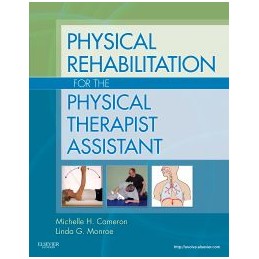- Reduced price

Order to parcel locker

easy pay


 Delivery policy
Delivery policy
Choose Paczkomat Inpost, Orlen Paczka, DHL, DPD or Poczta Polska. Click for more details
 Security policy
Security policy
Pay with a quick bank transfer, payment card or cash on delivery. Click for more details
 Return policy
Return policy
If you are a consumer, you can return the goods within 14 days. Click for more details
Prepare for practice with the book tailored specifically for physical therapist assistants! Physical Rehabilitation for the Physical Therapist Assistant provides a clear, easy-to-read, evidence-based guide to the PTAs role in patient management, covering the core concepts related to physical rehabilitation and emphasizing the PTAs role in intervention. A treatment-oriented focus addresses each of the four categories of the American Physical Therapy Association (APTA) Preferred Practice Patterns:: musculoskeletal, neuromuscular, cardiopulmonary, and integumentary. The final section of the book addresses interventions which overlap many practice patterns. Written by rehabilitation experts Michelle Cameron, MD, PT and Linda Monroe, MPT, in consultation with Susan Schmidt, a practicing PTA, and Carla Gleaton, the director of a PTA education program, this text will be a valuable resource both in the classroom and in professional practice.
Data sheet
1. Introduction 2. Evidence-based Practice Part One: Musculoskeletal System 3. Skeletal Demineralization 4. Posture 5. Muscle Weakness 6. Connective Tissue Dysfunction 7. Localized Inflammation 8. Spinal Disorders 9. Fractures 10. Joint Arthroplasty 11. Soft Tissue Surgery 12. Amputation and Prostheses Part Two: Neuromuscular System 13. Balance and Fall Risk 14. Impaired Neuromotor Development 15. Pediatric Nonprogressive Central Nervous System Disorders 16. Adult Nonprogressive Central Nervous System Disorders 17. Progressive Central Nervous System Disorders 18. Peripheral Nerve Injuries 19. Polyneuropathies 20. Nonprogressive Spinal Cord Disorders 21. Disorders of Consciousness: Coma, Vegetative State and Minimally Conscious State Part Three: Cardiopulmonary System 22. Vital Signs 23. Deconditioning 24. Airway Clearance Dysfunction 25. Congestive Heart Failure 26. Respiratory Failure 27. Lymphatic System Disorders Part Four: Integumentary System 28. Tissue Healing and Pressure Ulcers 29. Vascular Ulcers 30. Neuropathic Ulcers 31. Burns Part Five: Interventions Common to Many Conditions Requiring Rehabilitation 32. Gait Assessment and Training 33. Assistive Devices for Mobility: Canes, Crutches, Walkers, and Wheelchairs 34. Orthotics
